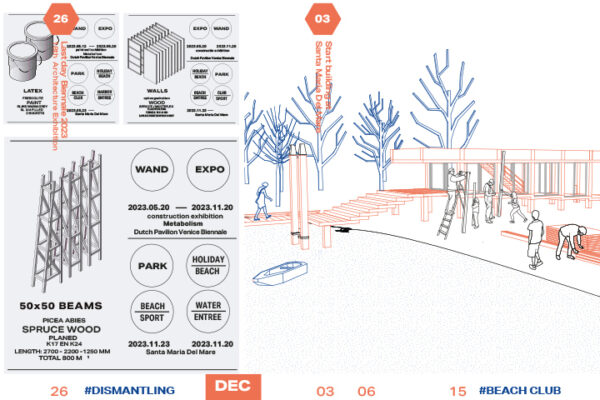

Venice Architecture Biennale 2023 – 3 projects selected
Three projects have been selected in the Open Call Venice Architecture Biennale 2023 – The Biennale as Metabolism. A reflection on the selection.
background
Het Nieuwe Instituut and the Creative Industries Fund NL launched an open call in July 2022 for the Dutch pavilion’s parallel programme at the eighteenth edition of the Venice Architecture Biennale. For the call, architects, landscape architects, urban designers and spatial researchers could submit proposals that, in line with the overarching theme of the 2023 biennale, The Laboratory of the Future, expose the invisible flows of materials, waste and labour hidden behind the presentations at the biennale. Identifying and visualizing this metabolism can increase the understanding and awareness needed to develop a biennale that makes a positive, sustainable contribution to Venice’s ecosystem.
selection
The following three projects have been selected:
Onur Can Tepe – Once upon a Time, a Sheet of Plywood arrived in Venice
Once upon a Time, a Sheet of Plywood arrived in Venice is a film project about the journey of physical materials and the associated labour involved in decorating the biennale. The film is being made by architect, writer and filmmaker Onur Can Tepe. Based on an investigation, the designer plans to make a short documentary combining moving images and photography. The aim of the format is to explore the external effects of the Venice biennale and depict the metabolism behind the biennale through storytelling. During the making of the film, several research questions are central, such as ‘What distances do materials have to travel for exhibitions in Venice?’ and ‘Who are the people building the pavilions, how far did they have to travel and what is their life like in Venice?’ The result will be screened at an event in Rotterdam and an event in Venice. At a later stage, work will be carried out on a full-length documentary that will further explore and depict the flows of materials, labour, tourists, knowledge and money that pass through Venice.

V8 Architects – Mapping the mental metabolism
In the project Mapping the Mental Metabolism, V8 Architects reflects on the flows of knowledge generated by architecture biennales. In a three-month research programme, V8 Architects aims to capture the legacy of the architecture biennale over time. The design of the study is based on three metaphorical trading ships, a recognizable symbol for the citizens of Venice. A trading ship is the laboratory of both the past and the future. Each ship has a focus, and together these define the identity and value of the architecture biennale. The first ship, Vessel of Knowledge, explores the visible and invisible knowledge produced at each edition of the architecture biennale. Vessel of Materials addresses the question ‘What are the production chains that support and enable the architecture biennale?’ During the architecture biennale Vessel of Interaction examines the interactions between architects and their fellow professionals, as well as between tourists and residents, and between visitors and the city. The study will result in an in-depth mapping of the metabolism of the architecture biennale and will be presented through interviews, an exhibition, a workshop and a publication.

Ester van de Wiel – RE-SOURCE
With the project RE-SOURCE, Ester van de Wiel is researching the residual flows that arise from the biennale, and the 2023 entry for the Dutch pavilion in particular. She has been tracking the history of Dutch contributions to the architecture biennale since 2010, providing insight into aspects such as development, preparation, transport, teams and materials. By looking at what locations, systems, people and operations are involved, she aims to chart the flows of residual materials. Apart from physical elements – such as plinths, walls and stages – publications, transport crates, packaging of materials, banners and knowledge gained are also being examined. In this way, Van de Wiel aims to initiate a discussion on ways in which exhibition practices can productively utilize residual material streams as resources in a socio-material context. For this research project, she is working closely with Bouwko Landstra’s construction team, which has been involved in the construction of the Dutch pavilion in the past six editions. Their experience and expertise on building materials and methods from previous editions will therefore be included in the study.
The three selected proposals each question the flows behind the bienniale in a different way. What is strong about the selected proposals is how the questions are focused on the Venetian context with the involvement of relevant local partners. The projects are expected to lead to complementary and innovative insights that will add value to both the bienniale and the city.
assessment
The proposals were submitted to three experts for advice: Femke Bijlsma (exhibition maker at Kossmanndejong, lecturer Tilburg University of Applied Sciences), Jan Jongert (architect, founder Superuse Studios) and Jane da Mosto (founder and director We are here Venice).
To arrive at a selection, the proposals were assessed according to the following criteria:
- The relationship to the theme The Biennale as Metabolism;
- Relevance to the field of contemporary architecture;
- The ability to raise relevant profession-related and societal issues and use various channels for their dissemination.
The assessment took the form of a tender: a number of proposals were preferred to the other submissions.
numbers
From the 16 proposals assessed, 3 were selected, bringing the percentage of applications being awarded grants to 19%. A budget of € 50,000 was available for this open call. The maximum contribution per project was € 25,000. The Venice Architecture Biennale will take place from 20 May to 26 November 2023.



